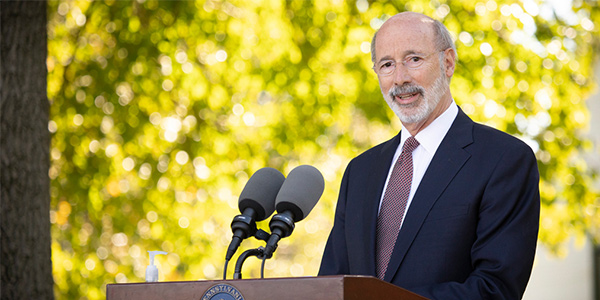Pennsylvania is set to take a leap in its renewable energy procurement in what officials are describing as the largest solar commitment by any state government in the U.S.
Gov. Tom Wolf announced Monday that nearly 50% of the electricity used by the state government will be produced by seven new solar energy arrays comprising 191 MW of capacity to be built around Pennsylvania. Pennsylvania PULSE (Project to Utilize Light and Solar Energy) will go into operation in January 2023 as part of the governor’s GreenGov initiative created in 2019. (See Pennsylvania Joins US Climate Alliance.)
Wolf said when he introduced the GreenGov initiative, he challenged the state government to lead by example through lowering greenhouse gas emissions in state operations and to obtain at least 40% of electricity from renewable resources.
The governor also cited the May sunset date of Pennsylvania’s Alternative Energy Portfolio Standard — which drove solar and renewable development for the past 15 years — as a spark to making local renewable energy markets strong.
“Pennsylvania has been a national energy leader for more than 100 years,” Wolf said. “As we continue to diversify our grid with clean, renewable sources of energy, we want to maintain Pennsylvania’s leadership position and bring the associated economic, health and environmental benefits to all Pennsylvanians.”
The solar arrays will be built in seven locations in six counties, including Columbia, Juniata, Montour, Northumberland, Snyder and York. Officials said the 191-MW project is expected to deliver 361,000 MWh per year and supply 100% of energy for 434 accounts across 16 state agencies, or roughly half the electricity used by state government.
The solar usage will reduce carbon dioxide emissions statewide by 157,800 metric tons each year, officials said, the equivalent of emissions from around 27,000 homes or 34,000 cars.
Lightsource BP, a utility-scale solar developer, will build, own and operate the solar arrays, creating hundreds of new construction jobs. The arrays will be built on as much as 2,000 acres of farmland, with farmers signing 30-year leases with Lightsource.
Kevin Smith, CEO of Lightsource BP of the Americas, said the private long-term ownership of the arrays teamed up with government entities procuring the electricity is a “great model” that can be replicated across the country. Smith said Lightsource, which is headquartered in Philadelphia, currently owns and operates four solar arrays generating 90 MW of power in the state.
“What the Commonwealth of Pennsylvania is doing is a model for other governments in the U.S. to address climate change and usher in a new sustainable era, bringing measurable job and economic benefits to its people while reducing emissions that lead to healthier citizens,” Smith said.
The Pennsylvania Department of General Services contracted with Exelon subsidiary Constellation to secure a 15-year fixed-price supply agreement for about 5 cents/kWh.
The solar renewable energy credits created by the projects will be retired when purchased by Pennsylvania, officials said, guaranteeing they won’t be used by other entities looking for renewable credits for climate goals.
Secretary Opinions
Secretary of General Services Curt Topper said the contract with Constellation provides the state with “long-term price protection and budget certainty.”
“Pennsylvania PULSE reflects our commitment to making renewable energy the heart of DGS energy strategy,” Topper said. “We’re excited to have this new model in place as we work toward more clean energy use in the future.”
Governor Wolf’s Climate Change Executive Order in 2019 set a goal of lowering Pennsylvania’s GHG emissions 26% by 2025 and 80% by 2050 compared with 2005 levels.
The order also re-established the GreenGov Council, made up of the secretaries of the departments of General Services, Environmental Protection (DEP) and Conservation and Natural Resources (DCNR), which was originally charged with developing strategies for GHG reductions. Other goals for the group included reducing energy usage by state government at least 3% annually and replacing 25% of the state vehicle fleet with electric vehicles.
DEP Secretary Patrick McDonnell said Pennsylvania needs to move toward renewable energy in every sector of the government and economy to step up to meet GHG reductions. McDonnell cited power plants, transportation and manufacturing as key groups in meeting goals.
He said Pennsylvania needs to be more aggressive with its solar deployment, with only 1% of electricity in the state currently coming from 700 MW of installed solar capacity. He added that Pennsylvania can get 10% of its electricity from solar if it can reach 11 GW of installed solar capacity by 2030.
“Solar energy at an enterprise scale, as Pennsylvania PULSE demonstrates, will make a big impact,” McDonnell said. “The cleaner the grid is, the cleaner other greenhouse gas mitigations will be, such as switching to electric transportation.”


